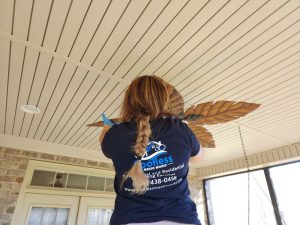Licensed And Insured

How to Clean a Used Couch: A Complete Guide
A used couch can be a great find—whether you’ve picked one up at a thrift store, online marketplace, or received it as a hand-me-down. However, before you settle in, it’s essential to give it a thorough clean to ensure it’s fresh, hygienic, and free of any lingering odors or stains. In this guide, we’ll walk you through the steps on how to clean a used couch effectively, restoring it to a like-new condition.
1. Vacuum the Couch
The first step in cleaning a used couch is to vacuum every surface thoroughly. This removes loose dirt, dust, pet hair, and any other debris that has settled on the couch over time. For upholstery cleaning, using a vacuum cleaner with an upholstery attachment will help you get into the seams, corners, and cushions. Be sure to:
- Remove and vacuum under any removable cushions.
- Pay special attention to crevices, where dust and crumbs can accumulate.
- Use a soft brush attachment to avoid damaging delicate fabrics.
By starting with a thorough vacuuming, you’re prepping the couch for deeper cleaning.
2. Disinfect and Wipe Down
Once you’ve vacuumed, it’s time to disinfect and wipe down the surfaces. This is particularly important for leather or faux leather couches, which can harbor germs and bacteria on the surface. For fabric couches, using a light fabric-safe disinfectant is ideal to ensure you kill any germs without damaging the material.
- For leather or vinyl couches, use a mild cleaner and a damp cloth to wipe down the surfaces.
- For fabric, lightly mist a disinfectant spray that is safe for fabrics.
- Let the couch dry naturally or speed up the process with a fan.
Wiping down your couch helps remove the grime that vacuuming might have missed and ensures that it’s free from bacteria and dirt.
3. Bug Spray (Optional)
If you’re concerned about potential pests like bed bugs, especially with a second-hand couch, you can use a bug spray that’s safe for upholstery cleaning. Be sure to follow the product’s instructions carefully, as certain sprays might not be compatible with delicate fabrics.
- Spray the entire couch and cushions, focusing on crevices where bugs could hide.
- Allow the spray to dry completely before continuing with other cleaning steps.
Though this step is optional, it provides extra peace of mind, especially when dealing with used furniture.
4. Remove Odors
One common issue with used furniture is the smell. Over time, odors from pets, spills, and daily use can linger on the fabric. Here’s how to remove odors from a couch effectively:
- Baking soda: Sprinkle baking soda generously across the entire couch, focusing on areas that have absorbed the most odors. Let it sit for at least 15 minutes, or up to an hour for stronger smells. Then, vacuum it up to freshen the couch.
- Vinegar and water solution: For fabric couches, a mixture of equal parts white vinegar and water can help neutralize odors. Lightly mist the couch with this solution, avoiding oversaturation, and allow it to air dry.
By using these methods, you’ll significantly reduce any unpleasant smells that may have built up on your couch.
5. Remove Stains
Now comes one of the trickiest parts of cleaning a used couch: dealing with stains. Stains from food, drinks, or pets can be difficult to remove if they’ve set into the fabric. Here are some effective couch stain removal techniques:
- Mild detergent: Mix mild dish soap with warm water and use a soft cloth to dab the stained area gently. Avoid scrubbing, as this can damage the fabric.
- Vinegar and baking soda paste: For tough stains, mix vinegar and baking soda into a paste and apply it to the stain. Let it sit for 10-15 minutes before wiping it away with a damp cloth.
- Fabric cleaner: Use a fabric-specific cleaner for stubborn stains that can’t be removed with household items.
Each couch material responds differently to cleaning solutions, so always test a small, hidden area first before applying any solution to the entire stain.
6. Removing Stains From a Couch
Dealing with tough stains requires a bit more effort and care. Whether it’s a fabric or leather couch, different stains need different treatments. Here’s how to deep clean specific stains from a used couch:
- Food stains: A water and dish soap solution usually works well for fresh food stains. Dab, don’t rub, to avoid spreading the stain.
- Grease stains: Apply baking soda directly to the grease stain, let it sit for a few minutes to absorb the grease, and then vacuum it up. Repeat if necessary.
- Ink or dye stains: For leather or vinyl, rubbing alcohol can help lift ink stains. Be sure to use a soft cloth and only apply a small amount at a time.
For fabric couches, deep clean sofa stains by using steam cleaners or fabric-safe cleaning products. Always check the cleaning instructions provided by the manufacturer to avoid damaging the material.
Bottom Line
Knowing how to clean a used couch can make a world of difference, turning a second-hand piece of furniture into something fresh, comfortable, and inviting. By following these steps—vacuuming, wiping down, deodorizing, and addressing stains—you’ll have your couch looking (and smelling) like new in no time.
Whether it’s a leather, fabric, or microfiber couch, the key is consistency and using the right products for your upholstery. A deep clean not only improves the couch’s appearance but also ensures that it’s hygienic and free from hidden dust or allergens.
So next time you find a great deal on a used couch, don’t hesitate—just follow this guide and transform it into a clean, cozy piece for your home!



